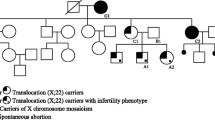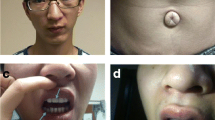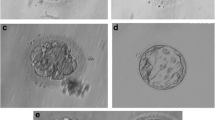Summary
We report a case of an X-autosome translocation t(X;4)(q13;p16) found in both sexes in three generations. The anomaly was diagnosed in a couple referred for cytogenetic investigation as a result of three spontaneous abortions. With the exception of the miscarriages there are no particularities in the gynecologic data of the woman or in the pedigree. In all 50 lymphocytes and in 66 of 68 fibroblasts investigated the normal X chromosome was the late replicating one.
Similar content being viewed by others
References
Allerdice PW, Miller OJ, Miller DA, Klinger HP (1978) Spreading of inactivation in an (X;14) translocation. Am J Med Genet 2:233–240
Diedrich U, Hansmann I, Janke D, Opitz O, Probeck HD (1983) Chromosome anomalies in 136 couples with a history of recurrent abortions. Hum Genet 65:48–52
Distèche CM, Eicher EM, Latt SA (1981) Late replication patterns in adult and embryonic mice carrying Searle's X-autosome translocation. Exp Cell Res 133:357–362
Dutriallaux B (1974) Study of human X chromosomes with the 5-BrdU-acridine orange technique. Applications to X chromosome pathology. Chromosomes today, vol 5: Proc Leiden Chromosome Conference, July 15–17, pp 395–407
Engel W, Klemme B, Probeck HD, Hansmann I (1982) H-Y-antigen in Turner-patients with different sex chromosome constitutions. Hum Genet 59:333–336
Madan K (1983) Balanced structural changes involving the human X: Effect on sexual phenotype. Hum Genet 63:216–221
Mattei MG, Mattei JF, Vidal J, Giraud F (1981) Structural anomalies of the X chromosomes and inactivation center. Hum Genet 56:401–408
Mattei MG, Mattei JF, Ayme S, Giraud F (1982) X-autosome translocations: Cytogenetic characteristics and their consequences. Hum Genet 61:295–309
Sarto GE, Therman E, Patau K (1973) X inactivation in man: A woman with (Xq-; 12q+). Am J Hum Genet 25:262–270
Sperling K, Wiesner R (1972) A rapid technique for routine use in human and comparative cytogentics. Hum Genet 15:349–353
Takagi N (1980) Primary and secondary nonrandom X chromosome inactivation in early female mouse embryos carrying Searle's translocation T (X;16) 16 H. Chromosoma 81:439–459
Yamamoto Y, Endo Y, Kuroki Y (1979) A case of partial trisomy 17 resulting from X-autosomal translocation. J Med Genet 16:395–399
Yunis JJ (1981) Mid-prophase human chromosomes. The attainment of 2000 bands. Hum Genet 56:293–298
Author information
Authors and Affiliations
Rights and permissions
About this article
Cite this article
Diedrich, U., Hansmann, I. A familial X-autosome translocation with the breakpoint in the “critical region”. Hum Genet 70, 281–283 (1985). https://doi.org/10.1007/BF00273458
Received:
Revised:
Issue Date:
DOI: https://doi.org/10.1007/BF00273458




